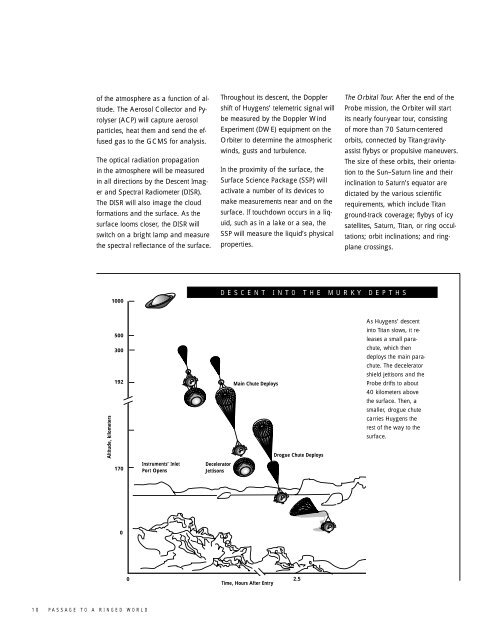Passage to a Ringed World - NASA's History Office
Passage to a Ringed World - NASA's History Office
Passage to a Ringed World - NASA's History Office
Create successful ePaper yourself
Turn your PDF publications into a flip-book with our unique Google optimized e-Paper software.
10 PASSAGE TO A RINGED WORLD<br />
of the atmosphere as a function of altitude.<br />
The Aerosol Collec<strong>to</strong>r and Pyrolyser<br />
(ACP) will capture aerosol<br />
particles, heat them and send the effused<br />
gas <strong>to</strong> the GCMS for analysis.<br />
The optical radiation propagation<br />
in the atmosphere will be measured<br />
in all directions by the Descent Imager<br />
and Spectral Radiometer (DISR).<br />
The DISR will also image the cloud<br />
formations and the surface. As the<br />
surface looms closer, the DISR will<br />
switch on a bright lamp and measure<br />
the spectral reflectance of the surface.<br />
Altitude, kilometers<br />
1000<br />
500<br />
300<br />
192<br />
170<br />
0<br />
Instruments’ Inlet<br />
Port Opens<br />
Decelera<strong>to</strong>r<br />
Jettisons<br />
Throughout its descent, the Doppler<br />
shift of Huygens’ telemetric signal will<br />
be measured by the Doppler Wind<br />
Experiment (DWE) equipment on the<br />
Orbiter <strong>to</strong> determine the atmospheric<br />
winds, gusts and turbulence.<br />
In the proximity of the surface, the<br />
Surface Science Package (SSP) will<br />
activate a number of its devices <strong>to</strong><br />
make measurements near and on the<br />
surface. If <strong>to</strong>uchdown occurs in a liquid,<br />
such as in a lake or a sea, the<br />
SSP will measure the liquid’s physical<br />
properties.<br />
The Orbital Tour. After the end of the<br />
Probe mission, the Orbiter will start<br />
its nearly four-year <strong>to</strong>ur, consisting<br />
of more than 70 Saturn-centered<br />
orbits, connected by Titan-gravityassist<br />
flybys or propulsive maneuvers.<br />
The size of these orbits, their orientation<br />
<strong>to</strong> the Sun–Saturn line and their<br />
inclination <strong>to</strong> Saturn’s equa<strong>to</strong>r are<br />
dictated by the various scientific<br />
requirements, which include Titan<br />
ground-track coverage; flybys of icy<br />
satellites, Saturn, Titan, or ring occultations;<br />
orbit inclinations; and ringplane<br />
crossings.<br />
DESCENT INTO THE MURKY DEPTHS<br />
Main Chute Deploys<br />
Drogue Chute Deploys<br />
0 2.5<br />
Time, Hours After Entry<br />
As Huygens’ descent<br />
in<strong>to</strong> Titan slows, it releases<br />
a small parachute,<br />
which then<br />
deploys the main parachute.<br />
The decelera<strong>to</strong>r<br />
shield jettisons and the<br />
Probe drifts <strong>to</strong> about<br />
40 kilometers above<br />
the surface. Then, a<br />
smaller, drogue chute<br />
carries Huygens the<br />
rest of the way <strong>to</strong> the<br />
surface.
















